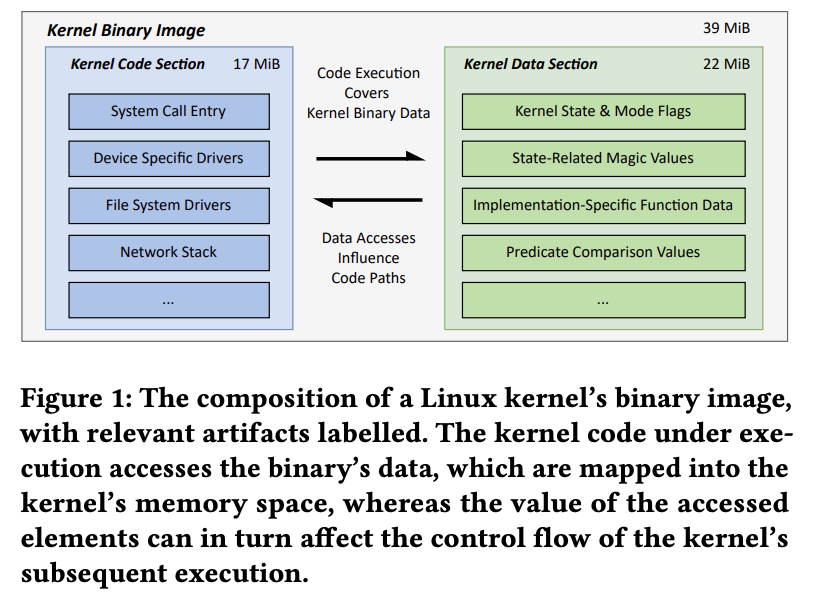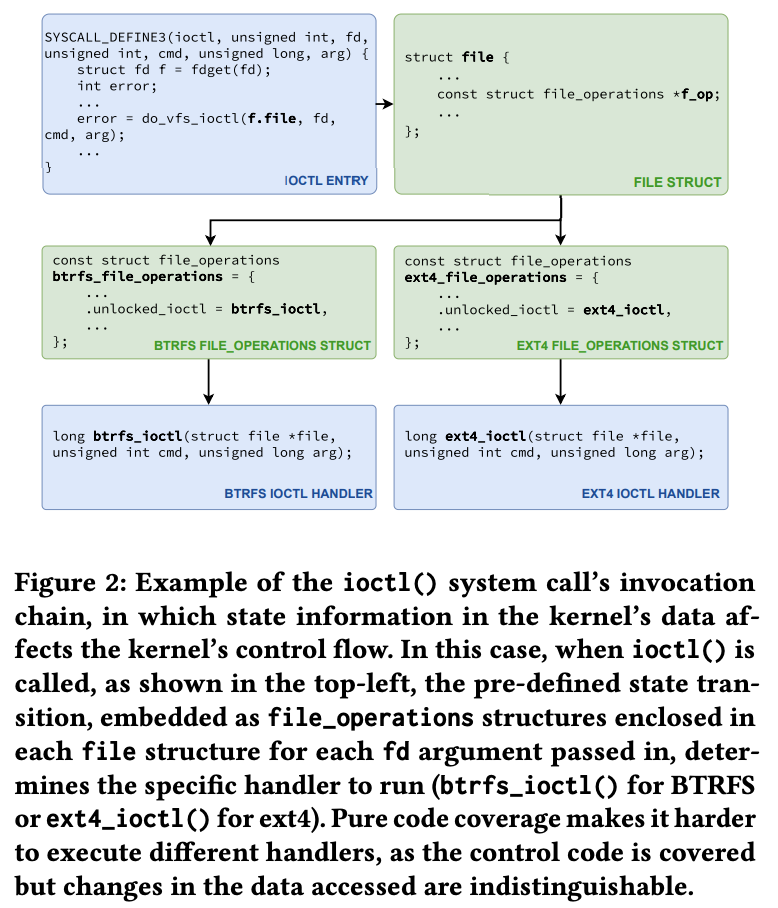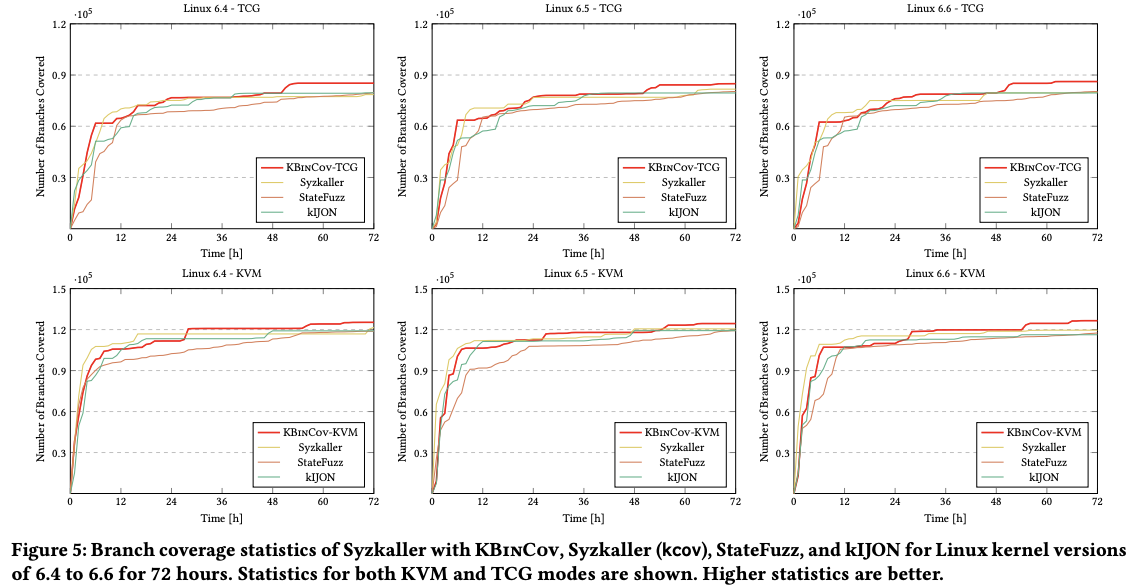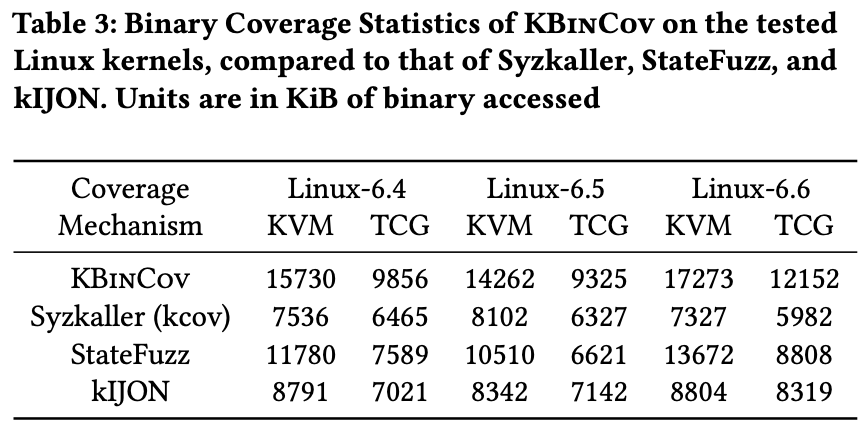Leveraging Binary Coverage for Effective Generation Guidance in Kernel Fuzzing
Jianzhong Liu, Yuheng Shen, Yiru Xu, Yu Jiang
- Read: 01 May 2025
- Published: 09 Dec 2024
CCS ‘24: Proceedings of the 2024 on ACM SIGSAC Conference on Computer and Communications Security, Pages 3763 - 3777
https://doi.org/10.1145/3658644.3690232
Q&A (link)
What are the motivations for this work?
- See Abstract, Introduction, Section 3.
- Code coverage is not sufficient for operating system kernel fuzzers, since kernels contain many untracked but interesting features, such as comparison operands, kernel state identifiers, flags, and executable code, within its data segments, that reflects different execution patterns.
- Current kernel fuzzing technologies can only allow fuzzers to explore a less-than-desired amount of the kernel’s code and logic, typically reaching their limits within several days into a fuzzing campaign.
- AFL++ has included context (where the state of program was when the code was executed) into coverage metrics, but it is still restricted to covering the code section alone.
- As the figure shown below, a Linux v6.6.8 compiled to the amd64 target has 43% executable code and 57% data, so adding data to coverage feedback potentially allows 2.3x coverage than pure code-based approaches.

- As the figure shown below, a significant amount of source code for
ioctlsyscall from Linux kernel v6.9 is compiled to data section, and it determines whether a certain handler in code section can be executed.
What is the proposed solution?
- See Introduction, Section 4.
- Abstract kernel behavior as its temporal and spatial memory access pattern during execution. Use this pattern as code coverage metrics.
- Optimizations needed for efficient representation of memory access pattern.
- Address approximation for data embedded in instructions (faster, less accurate addr).
- Use static analysis during instrumentation, tracing elision, to remove tracing points that contribute redundant coverage info.
- Multi-level cache-friendly coverage storage.
- Overview of the feedback system.

What is the work’s evaluation of the proposed solution?
- See Abstract, Section 6.
- Compared against state-of-the-art kernel fuzzers on recent versions of the Linux kernels.
- Code and binary coverage increases of 7%, 7%, 9% and 87%, 34%, 61%, compared to Syzkaller, StateFuzz, and IJON.
- 1.74x overhead, while StateFuzz is 2.5x, IJON is 2.2x.
- In Section 6, the authors presents four eval criteria:
- Overall effectiveness in coverage improvements.
- Overall efficiency and accuracy.
- Effectiveness of individual and component-wise design choices.
- Real-world bug detection capabilities.
- Branch coverage with KVM gets to an average of 124141 branches on the three versions of Linux kernel.

- Binary coverage statistics, with units in KiB.

- Combining binary coverage and branch coverage.

- The coverage experiments are conducted for 72 hours. All bugs listed were found in this experiment. Each experiment was repeated 5 times to reduce statistical errors.
What is your analysis of the identified problem, idea and evaluation?
They didn’t open source their code.
What are the contributions?
- See Abstract.
- A new execution feedback and novelty detection mechanism, Kernel Binary Coverage Feedback.
- A prototype tool KBinCov integrated into kernel fuzzer syzkaller.
- Higher code and binary coverage, lower overhead.
- Found 21 previously unknown bugs using KBinCov with Syzkaller.
What are future directions for this research?
NONE
What questions are you left with?
NONE
What is your take-away message from this paper?
- Including memory pattern in kernel code coverage metrics can be benefitial as it includes more info.
- The memory overhead introduced by memory pattern is affordable, while the run-time overhead might be higher than state-of-the-art implementations. In the experiments, it takes KBinCov longer execution time to really achieve a better result.
- In Section 6.2, the authors explained that QEMU-KVM has significantly higher coverage statistics than QEMU-TCG, due to the fact that QEMU enabled a different set of devices under the two modes, thus affecting the number of modules the kernel loads during initialization, and in turn resulting in a difference in the figures when saturated.
Written on

